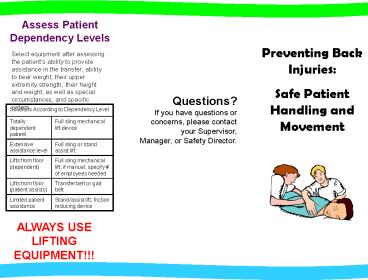Questions? PowerPoint PPT Presentation
1 / 2
Title: Questions?
1
Assess Patient Dependency Levels
Preventing Back Injuries Safe Patient Handling
and Movement
Select equipment after assessing the patients
ability to provide assistance in the transfer,
ability to bear weight, their upper extremity
strength, their height and weight, as well as
special circumstances, and specific orders
Questions? If you have questions or concerns,
please contact your Supervisor, Manager, or
Safety Director.
Solutions According to Dependency Level Solutions According to Dependency Level
Totally dependent patient Full sling mechanical lift device
Extensive assistance level Full sling or stand assist lift
Lifts from floor (dependent) Full sling mechanical lift if manual, specify of employees needed
Lifts from floor (patient assists) Transfer belt or gait belt
Limited patient assistance Stand/assist lift friction reducing device
ALWAYS USE LIFTING EQUIPMENT!!!
2
DISABLING INJURIES
Every day, nurses suffer debilitating and often
career-ending and life-altering injuries from
repeatedly lifting and moving patients. Back
injuries affect up to 38 of all nurses. More
than any other work-related injury or illness,
musculoskeletal disorders (MSDs) are responsible
for lost work time, the need for protracted
medical care, and permanent disability among
health care workers. MSDs are caused by any
combination of the following factors Awkward or
fixed posture working in an awkward position or
holding the same position for a long time. For
example Repositioning or turning patients in
bed (side rails are up, bed is too low, and the
provider reaches across patient) Attaching gait
or transfer belts with handles (the bed or chair
is too low or far away) Providing in-bed
medical care (the bed is too low and side rails
are up) Washing patients legs and feet in a
shower chair (the shower chair is too low and
access is limited) Repetitive tasks repeated
repositioning in bed, numerous transfers to and
from beds, chairs, or commodes without rest
breaks. Forceful exertions lifting or
transferring heavy patients, unexpected or abrupt
forceful motions, stopping patient falls or
lifting them off the floor after a
fall. Standing standing for more than four hours.
LIFTING EQUIPMENT
Shower chairs, which fit over the toilet, can eliminate multiple transfers, saving healthcare workers multiple lifts. A patient can be moved to the shower chair, toileted, showered, and transferred back to bed.
Shower stalls should allow for shower chairs to be pushed in and out on level floor surfaces. Use a standard shower without the front lip to allow for easy access.
Toilet seat risers should be used to equalize the height of the wheelchair and the toilet seat, making it a lateral transfer rather than a lift up and back into the wheelchair.
Height-adjustable electric beds have height controls to allow for easy transfer from bed height to wheelchair height. These beds can be kept low to the ground for patient safety and then raised up for interaction with staff. Avoid hand-cranked beds, which can lead to wrist/shoulder musculoskeletal disorders such as strain or repetitive motion injuries.
Good work practices must be combined with the use
of appropriate equipment. Not all lifting devices
are the same. Proper equipment selection depends
on the specific needs of the facility.
Technical lift equipment helps lift patients who cannot support their own weight. Choose a lift that does not require manual pumping to avoid possible repetitive motion disorders to workers arms and shoulders. Lift equipment can be classified into two main categories lean-stand assist lift and sling-type full lift.
Multi-positional chairs provide a no-lift solution for patient transfers in a safe, dignified environment for both patient and caregiver. Easily converting between a stretcher and an upright mobile chair in seconds, the chair enables caregivers tocomfortably transfer and transport a patient weighing up to 250 pounds.
Overhead track-mounted resident lifters are built-in ceiling track systems to which sling lifts attach.

